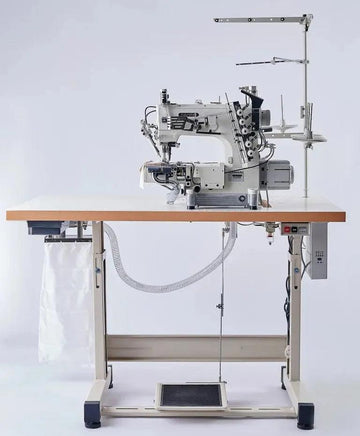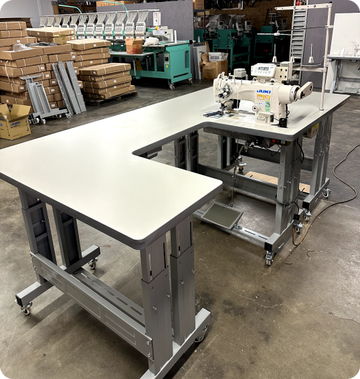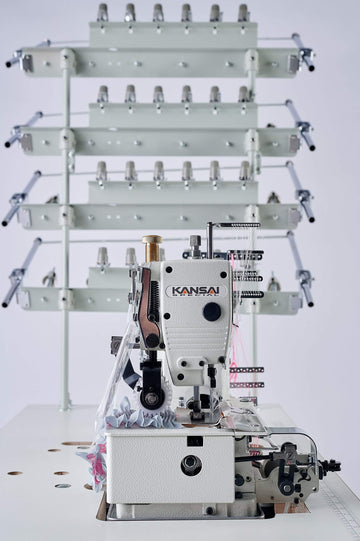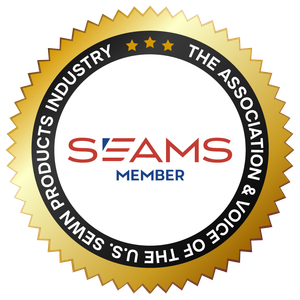A sewing machine is a great piece of equipment that can be highly versatile. There are multiple types of sewing machine stitches for different projects. Each time you need to complete a task, you should figure out what stitching technique would look good on your fabrics. To make the right choice, it's always best to test stitching on scrap fabric first. You may try creating straight stitches on silk and zigzag stitches on leather and denim. Considering the whole variety of stitches, you'll be amazed at what modern sewing machines have to offer!
What Are Sewing Machine Stitches?
A sewing machine stitch is a thread that keeps two or more pieces of fabric together. The needle moves through the fabric, creating one or more rows of stitches. Some sewing machines use a second thread from a bobbin to lock stitches in place.
Depending on the brand and model, a sewing machine can support one or many stitching techniques. Stitches can be decorative and functional, depending on their intended use. You may need a zigzag stitch on stretchy fabrics. You may also need a blind hem stitch for sewing dresses and skirts.
Stitching puts several layers of fabric together. Choosing the right type of sewing machine stitches ensures professional results in domestic or industrial settings. You need to use a specific presser foot to start stitching. When lowered, the presser foot holds the fabric against the feed dogs. Once you step on the foot control, you start creating stitches one by one.
Main Categories of Sewing Machine Stitches
Different stitches in sewing machine can be organized into several categories, such as:
Straight stitches are designed for basic stitching, topstitching, and hemming. Their length can be adjusted to individual needs. This type of stitch works for domestic and industrial tasks.
Zigzag stitches make the needle move back and forth to create a zigzag pattern. They can be used for finishing raw fabric edges and carefully sealing up loose threads. These stitches also add a stretch to the seams that look good on any type of fabric.
Decorative stitches are widely used in embroidery designs, enhancing the visual appeal of garments. Their length and width need to be adjusted to project needs. It may take longer to create a series of decorative stitches than it would using straight stitches. This can be a significant nuance for those who run out of time.
Stretch/elastic stitches are suitable for sewing stretchy fabrics like knits and spandex. Several rows of stitches prevent popped seams that experience a lot of movement or stretching. This type of stitch helps produce long-lasting, high-quality garments.
Specialty stitches are designed for limited functions. Buttonhole stitches are required for securing buttons. Blind hem stitches can help create invisible hems. Quilting stitches can be used for layering fabrics. These specialty stitches deliver professional finishes.
Common Types of Sewing Machine Stitches and Their Uses
Before starting your sewing project, you should check out different types of sewing machine stitches and pick the one that suits your needs most. The main options include:
A straight or running stitch is the most common type of stitch that can be used for basic sewing tasks. Passing the needle in and out of the fabric helps create plain seams. It also works for topstitching and hemming. The stitch length can be adjusted to sewing needs, from 0 to 6 mm. The shorter the stitch, the harder it is to remove.
A zigzag stitch creates a zigzag pattern with the needle moving left and right. Its strength and elasticity are suitable for various decorative projects. A zigzag stitch also helps avoid fraying by binding the raw edges of fabric. Its length and width can be adjusted according to the project's needs.
An overlock/serger stitch is an over-edge stitch that prevents fraying and achieves clean, secure finishes on fabric edges. It uses multiple threads and loopers to create a professional-looking seam, especially on stretchy fabrics. Overlock machines can also trim fabric edges as they stitch, saving time and ensuring accuracy.
A stretch stitch provides strong stitches on stretchy fabrics. The multiple lines of stitches allow the fabric to stretch without breaking the pattern. A basic sewing machine can sew a stretch stitch by using a narrow zigzag. A triple stretch setting also allows the thread and fabric to stretch further.
A blind hem stitch creates an invisible hem on skirts, pants, and dresses. It uses only a few threads of the fabric, making the stitch almost invisible on the right side. The stitch is perfect for achieving a professional and clean finish.
A buttonhole stitch creates buttonholes of different sizes and shapes (e.g., rectangular, rounded, keyhole, and stretch). It secures the raw edges and prevents fraying. To ensure clean buttonholes, you need to make the necessary adjustments in the machine settings.
A satin stitch finishes edges and adds decorative elements to sewing projects. It can be adjusted to different materials and designs, offering a polished look. The stitch is also widely used for intricate and elegant embroidery designs.
A quilting stitch keeps multiple layers of fabric together in quilting projects. It also adds a decorative touch to the finished item. Quilting stitches can look like straight lines or more intricate patterns such as curves, waves, or motifs.
A decorative embroidery stitch creates unique visual patterns for garments. Waves, flowers, and geometric shapes can give a more personalized touch to any fabric. You can experiment with thread, stitch length/width, and tension to see what suits your project needs.
Other specialty stitches serve as decorative elements, adding intricate patterns and unique textures. Scallop, feather, or heirloom stitches are widely used for embellishing garments, delivering creativity and personalization.
Read Also: What Is an Industrial Sewing Machine? Pros, Cons, and Everything You Need to Know
Choosing the Right Stitch for Fabric and Project
The right type of sewing machine stitch can help you meet your project needs. Consider a few things to make the right choice:
-
Light or heavy fabrics: Lightweight fabrics require simple stitches to reduce potential damage. Heavyweight fabrics require strong, durable stitches to sew several layers of fabric simultaneously.
-
Stretch or non-stretch fabrics: Stretchy fabrics require flexible stitches that would stay strong during movement. Straight stitches can provide enough stability and strength to non-stretch fabrics.
-
Decorative or functional stitching: Satin and quilting stitches can be used as an element of decor on any fabric. Buttonhole and blind hem stitches play a more functional role, which requires extra strength and durability.
Keep these considerations in mind to deliver professional output. Consider the type of fabric and project needs to come up with a suitable stitching technique.
How to Adjust Stitch Settings on a Sewing Machine
You adjust stitch settings based on your project needs. It’s critical to choose the right length. Shorter stitches (1–2 mm) are best for lightweight fabrics like cotton and silk. Longer stitches (3–4 mm) suit heavyweight fabrics like denim and leather. You also need to adjust the width for zigzag or decorative stitches. Straight stitches need to be narrow. Buttonholes require wider stitches.
Thread tension has a direct impact on how the top and bobbin threads interlock. Excessive tension may cause puckering. Insufficient tension may create uneven stitches. Balancing tension is crucial for delivering even stitches across lightweight and heavyweight fabrics. For more adjustments, read the sewing machine manual. Practice different sewing machine stitch types on a scrap fabric to choose one for your project needs.
Tips for Using Different Sewing Machine Stitches
Make sure to choose one of the sewing machine stitching types based on your project needs. Here are a few tips to help you out.
-
Test on scrap fabric first. Don’t jump right in and start sewing. Different threads require different tensions. Different fabrics require different stitching lengths and widths. Practice on a scrap fabric will help you choose the most suitable configuration.
-
Match the thread and needle to the fabric. Use the same type of thread on the top and the bottom to avoid uneven tension. The thread should also match the form and thickness of the needle.
-
Know where to reinforce stitches. Press and hold the reverse/reinforcement stitch button at the beginning and end of seams and in high-stress areas like the central seams of pants or the crotch seams.
With a smart approach, sewing can deliver excellent results. Go slow for precise maneuvers. Practice at a reasonable pace.
Conclusion
Understanding basic types of stitches on a sewing machine can truly elevate your project. Some stitches are functional while others are decorative, each bringing its own unique flair. Experiment with different stitches to check what works for your domestic or industrial needs. Make a choice based on the fabrics you sew and the patterns you need to deliver. Choose a sewing machine that could help you deliver an exceptional output in South El Monte, Los Angeles, California. Always refer to the instruction manual for stitching information.









